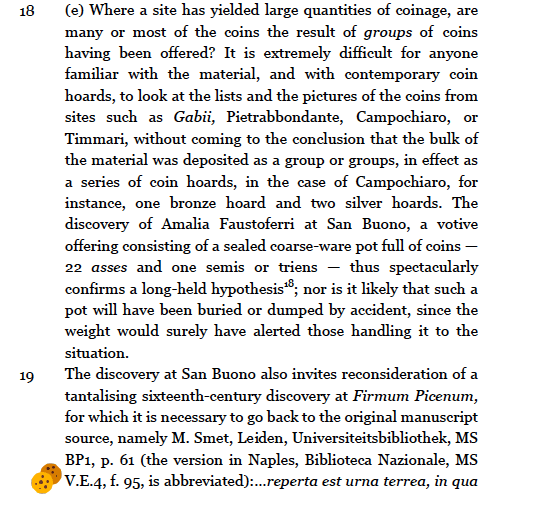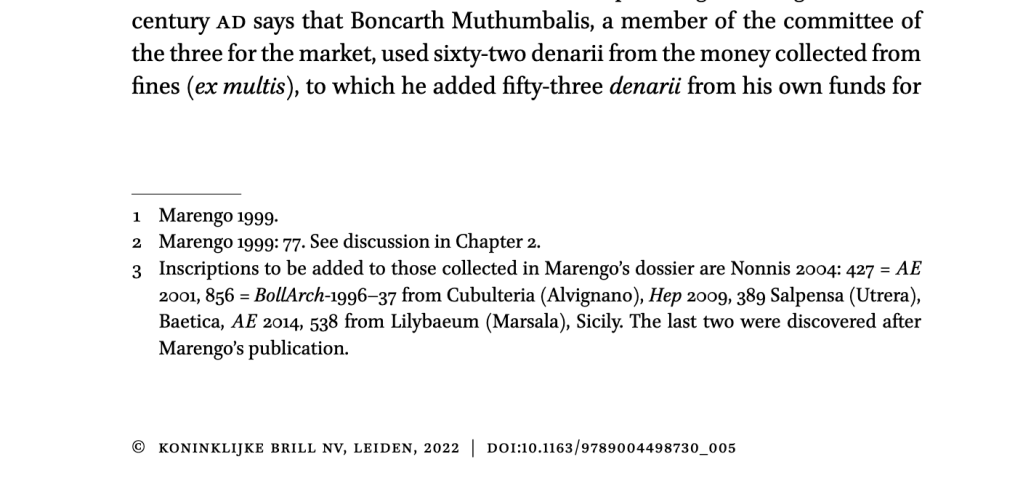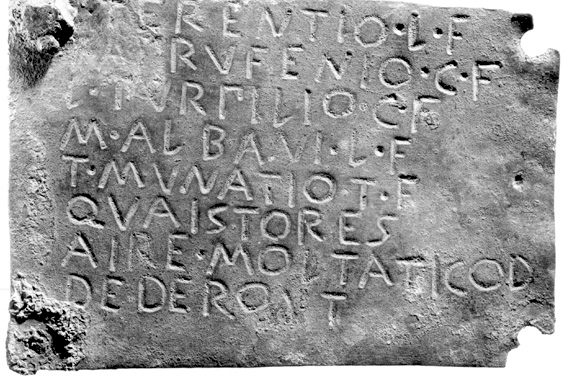Update later the same day.
Original post below. I write these as I dive in an I like to preserve my train of thought. And, then sometimes post publication new stuff is shared with me by generous colleagues, like Seth Bernard. Who found that Crawford has tracked down records of this hoard in 2003, AND had seen another more recent one that was then unpublished and so leaving yet another content list to track down.
What I don’t understand is why Crawford assumes these are denarii… or that the asses are of the struck variety rather than the cast. I don’t see anything in the Latin to confirm that summary. The epigraphic evidence would suggest 1st Punic War date at least to my untrained eye….



The meat of this article is really the appendices just masses of data on where coins were found.
This is not the post I started writing this morning. That one may appear later today or whenever it is finished, it’s on more aes grave bibliography I was reading. This is a side note…
I went looking for images/info on Mater Matuta to round out my understanding of a findcontext and landed on this Arachne search result and as I read I found a hoard report from a completely different part of the early Roman Italy!

Extremely frustratingly I can’t find the inscription (yet!) in any of the typical epigraphic databases (I tend to start with Clauss/Slaby) and that seems supremely odd as it is clearly published. I also checked Coin Hoards and came up with zilch. My thought is if I can find a better publication of the inscription I might find the coin types. The next stop was to figure out what type of quaestors are making this offering: fines officers!
This got me to an article I’ve now ILL requested:
Piacentin, Sofia. 2021. “Public Fines in Italy Outside Rome.” In Financial Penalties in the Roman Republic, pp. 60-76. Brill.
But! The publisher’s preview gave me a head start:


Turns out Marengo is a PROLIFIC epigrapher with numerous interesting publications that I am studiously not letting myself consider reading at this time. This is the relevant one for the above inscription:
Marengo, Silvia Maria. “Le « multae ».” In Il capitolo delle entrate nelle finanze municipali in Occidente ed in Oriente: actes de la Xe rencontre franco-italienne sur l’épigraphie du monde romain : Rome, 27-29 mai 1996,. Collection de l’École Française de Rome; 256, 73-84. Roma: Università degli Studi di Roma La Sapienza, 1999. Which gloriously turns out to be open access!
The above inscription with the coin hoard is her no. 2:

Which with this transcription let me get the databases to spit it out:
Publications: CIL 09, 05351 = CIL 01, 00383 (p 879) = CIL 05, *00429,012 = ILLRP 00593 = D 06132 = Questori 00278
and gave me an image too:

Still no more information on the hoard…. I guess I’ll have to track down all the publications at some point…
I did however let me try to retrieve it the plaque from Gallica (BnF image database). Picenum, Firmum, and Fermo, gave me nothing relevant, neither did ‘inscription’, but that last search term did return a whole host of yummy images, especially of the fragments of the tablette ilaques.

It was a long standing iron age settlement but made a Latin Colony c. 264 BCE (Vel. Pat. 1.14.8), and then sided with Hannibal… We can assume a deposition of this hoard was mid third century based on letter forms and history of the colony.
The development of the quaestorship in the third century has been a hot topic, furthered by the discovery of the Egadi Rams. I’m not sure yet how the use of the title in colonies intersects. I’ve not read enough. Here’s some starter bibliography…
Prag Jonathan R. W. The quaestorship in the third and second centuries BC. In: L’imperium Romanum en perspective. Les savoirs d’empire dans la République romaine et leur héritage dans l’Europe médiévale et moderne. Besançon : Institut des Sciences et Techniques de l’Antiquité, 2014. pp. 193-209. (Collection « ISTA », 1302) (open access – the whole volume is fascinating!)
Prag, J. (2014). Bronze rostra from the Egadi Islands off NW Sicily: The Latin inscriptions. Journal of Roman Archaeology, 27, 33-59. doi:10.1017/S1047759414001159
Prag, Jonathan R. W. “A Revised Edition of the Latin Inscription on the Egadi 11 Bronze ‘Rostrum’ from the Egadi Islands.” Zeitschrift Für Papyrologie Und Epigraphik 202 (2017): 287–92. http://www.jstor.org/stable/26603819.
Pina Polo, Francisco and Díaz Fernández, Alejandro. “Chapter 2: The development of the quaestorship and the so-called Italian quaestors”. The Quaestorship in the Roman Republic, Berlin, Boston: De Gruyter, 2019, pp. 25-50. https://doi.org/10.1515/9783110666410-004 (again the whole volume is super relevant)
Today
Lafayette replyReview grad student apps by Jan 19Finalize LETTER draft- Read more on Aes Grave
Circle back to department about any Jan planning meetings
Not Today (but maybe tomorrow, or the day after)
- post conference Rome accommodation
- Teaching requests for Fall 2023
- Set time table for any collaborative RRDP work/publication prep that needs to happen this semester: Chicago pub, INC pub, collaboration with RACOM, etc…
- Circle back to Capito project
- Consider ask for funding from Dean’s office
- Begin Med school rec letter
- record mini myth
- find out what is on that v old harddrive and back up to cloud
- Write up Teaching Eval
- Cancel at least one more digital membership
- renew Coinarchives
[…] distraction, the most lovely Seth Bernard sent me this via twitter because of my earlier post (not yet edited but soon to […]